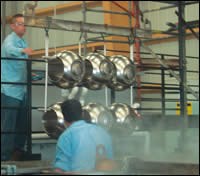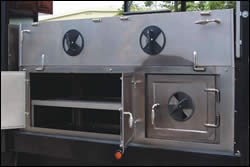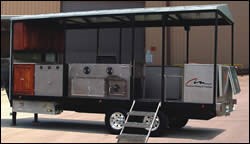Cooking up Business, Texas-style
Mobile cooker showcases company’s finishing capabilities
Houston Plating & Coatings (HP&C; South Houston, TX) is strategically located to take advantage of the surge in oil exploration brought about by record high crude oil prices. According to CEO William Howard, the company is combining some innovative business practices and “one-stop” finishing capability to expand its business in more ways than one: since Howard became CEO in 2003, the number of employees has doubled from 75 to 150, and revenues have tripled to nearly $15 million. In addition to its 75,000 sq ft main facility, HP&C now operates three satellite plants inside OEM customer facilities.
Earlier this year the company launched a new way to reward customers and drum up new business in true Texas fashion. In a state where fajitas and barbecue are taken very seriously, HP&C built a deluxe mobile cooker designed to be towed to industry events and customer plants. The 25-ft long trailer was built to highlight the company’s electroless nickel plating and salt bath nitriding capabilities.
“We had a tradition here of having an open house twice a year for customers,” explains CEO William Howard. “But a lot of them couldn’t come. It took too much time out of their day, or they’d only be able to send a couple of people. So we thought we’d go to them rather than them coming to us.”
The cooker was built entirely by HP&C staff and took more than a month to design and three months to fabricate. It features built-in stoves, temperature-controlled tortilla warming racks, a three-keg capacity cooler and tap system, custom cabinetry, nickel-plated grating for the floor, backup battery power, connections for running water, and even satellite radio capability.
Most of the materials for the cooker, including the trailer and nearly all the steel, were donated by HP&C customers. Construction began when workers extended the trailer frame by 4-1/2 ft, relocated the tandem rear axles to accommodate the change in the center of gravity, and located vertical supports to anchor the custom built stoves and storage units.
Because most of the materials were donated, Howard estimates HP&C was out of pocket only about $10,000 for the trailer. “I don’t know how much a trailer like this might cost if you tried to buy one,” he says. “Maybe $100,000 or more.
“But it’s kind of a unique thing. We show up at a customer’s facility and start cooking. Everyone in the shop can get lunch and a little break.”
HP&C plans to add smokers to enable the cooker to produce real Texas-style barbecue, he adds. “Right now, it’s not a barbecue smoker. We cook fajitas and steaks, and do more grilling than smoking,” Howard says.
Loads of Nickel
The cooker appears as though it makes use of a lot of polished stainless steel. In reality, it’s fabricated mainly using carbon steel plated with a high-phosphorus electroless nickel supplied by Sirius Technology Inc. (Oriskany, NY). EN (high-phosphorus) plated carbon steel is about half as expensive as stainless steel but provides far better corrosion protection and wear resistance.
The company’s Millennium ACN-10 chemistry is formulated to produce a semi-bright, high-phosphorus (10.5-12% by weight) deposit at a moderate rate of deposition. According to Sirius, the process yields a deposit with good ductility, low internal stresses, good solderability and excellent corrosion protection.
Bath operating parameters are 4.8–6.3 g/L of nickel metal, 24–31.5 g/L of reducer, and temperature of 185–205°F. pH range is 4.60–5.20, bath loading is 0.2–1.0 sq ft/gal, and plating rate is 0.4–0.6 mils/hr. Typical bath life processing steel parts is 8-10 turnovers.
HP&C’s EN capability is most often used for ball valves and other oilfield components weighing up to 28,000 lbs. Both of the main tanks on the company’s EN line are 3,200-gal capacity. One of the tanks is extra-deep to enable handing of parts up to 22 ft. in length.
The bulk of its EN business may be parts for oil exploration, but HP&C does other types of work as well. “We also do nickel plating, for example, on shotguns and rifles for a large firearms manufacturer,” he says. “The finish is harder and more corrosion-resistant than the standard finish.”
Salt Bath Nitriding
As part of Howard’s “one-stop shop” finishing philosophy, HP&C added a proprietary salt-bath nitrocarburizing process to its list of services at the end of 2004.
“There was only one other company in this part of the country doing this process, and it could take sometimes two weeks for customers to get parts processed,” Howard explains. “We had a number of customers ask us about it, so we did a survey and found out it made sense.”
HP&C had to purchase a license, buy the equipment, and erect a building to house the process, according to Howard. “We probably invested $1 million in that, but it’s been a good addition,” he says. “We have a number of customers that make parts requiring all three of our processes—EN, salt bath nitrocarburizing, and spray coating, so this investment made sense for us and for our customers.”
In the process, parts are immersed and held for specific dwell times in a molten salt bath at 1,075°F. Formulated to produce a nitriding potential, the initial bath is followed by quenching in a lower-temperature oxidizing salt bath and then cooling to room temperature. If needed for corrosion resistance or appearance, parts can then be polished and re-immersed in the oxidizing quench.
At HP&C, polishing is accomplished in blasting cabinets built by the company’s maintenance staff. “You could spend hours manually polishing parts and still not achieve the desired finish,” Howard says. “We use glass bead blasting, and the process doesn’t take more than a few minutes.
The process creates a hard, corrosion-resistant finish that doesn’t add measurable dimensions to the part. This is topped with a thin overlay of iron oxide, resulting in good wear and corrosion resistance and good lubricity in surface and near-surface layers of the part.
‘Frictionless’ Business
Howard sees little difference between his previous profession—he was a CPA working for a large accounting and consulting firm—and running HP&C. “At bottom, they’re both service businesses,” he says. “We don’t manufacture anything. To build your service business, you look at what your customers need and try to arrange your processes to match those needs in terms of what you’re offering, how you’re doing it, and most importantly, how to meet their deadlines.”
One area where HP&C has been innovative is in development of streamlined supply chains. Howard believes that developing an effective finishing supply chain requires collaboration between the finisher and the customer to minimize what he calls “friction”—the burdens and headaches associated with the way business is normally done that slow the production process.
“In a ‘normal’ supply chain, the manufacturer makes the parts,” he explains. “They then prepare the purchase order, package the parts, put them on a truck, and send them to us for finishing. We take whatever time it takes to get the job done, package the parts, put them back on a truck, and send them back.
“That might be 10 days. But there are ways to cut that 10 days to one or two days at the most.
HP&C and at least one of its big customers have taken the idea of a “frictionless” supply chain about as far as it can go by setting up HP&C satellite finishing shops in the customer’s plants.
“At one Baker Oil Tools plant, for example, we perform several coating operations in their facility,” Howard says. “We operate spray booths, phosphate tanks, ovens, blast cabinets, all in a small portion of their plant.
“So when they finish making a part, it comes just a few feet to us, not clear across town. We’re just the next item on the work order. They don’t have to prepare purchase orders or deal with invoices. We send them a bill once a month for the work we’ve done. It’s a very efficient process all the way around.”
Howard says a recent study completed by the Texas A&M University’s Supply Chain Systems Laboratory concluded that the value of a satellite coating operation in an OEM’s facility was considerably more than the actual costs spent on coating. “It’s good to know that our system can actually make money for our major OEM customers,” he notes.
Baker Oil Tools, a division of Baker Hughes Inc., manufactures carbon steel and stainless steel parts for drilling and other oilpatch operations. “In their facility, we do spray coatings for corrosion protection, wear resistance, and lubricity,” Howard says. “It’s a paint that’s formulated for wear and corrosion resistance. It’s very hard, and it’s very thin—0.002 in. thick.”
There must be something to Howard’s frictionless philosophy: since he became CEO of the company in 2003, the number of employees has doubled and revenue has tripled.
Related Content
Innovation in Plating on Plastic
Plating on advanced plastics solution offers improved adhesion, temperature resistance and cost savings.
Read MoreLiquid Chrome Vs. Chromic Acid Flake
Contemplating how to continue offering chromic acid services in an increasingly stringent regulatory world? Liquid chrome products may be the solution you’re looking for.
Read MoreTrivalent Chrome Overview
As the finishing industry begins to move away from the use of hexavalent chromium to trivalent chromium, what factors should finishers consider as they make new investments? Mark Schario, chief technology officer for Columbia Chemical offers a helpful overview of this complicated topic.
Read MoreSuccessful South African Plater Beating the Odds
Remaining focused on quality and reliability, Team Plating Works stays profitable in a volatile and challenging economy.
Read MoreRead Next
Education Bringing Cleaning to Machining
Debuting new speakers and cleaning technology content during this half-day workshop co-located with IMTS 2024.
Read MoreDelivering Increased Benefits to Greenhouse Films
Baystar's Borstar technology is helping customers deliver better, more reliable production methods to greenhouse agriculture.
Read MoreEpisode 45: An Interview with Chandler Mancuso, MacDermid Envio Solutions
Chandler Mancuso, technical director with MacDermid Envio discusses updating your wastewater treatment system and implementing materials recycling solutions to increase efficiencies, control costs and reduce environmental impact.
Read More

























